1997 CADILLAC ELDORADO light
[x] Cancel search: lightPage 286 of 361
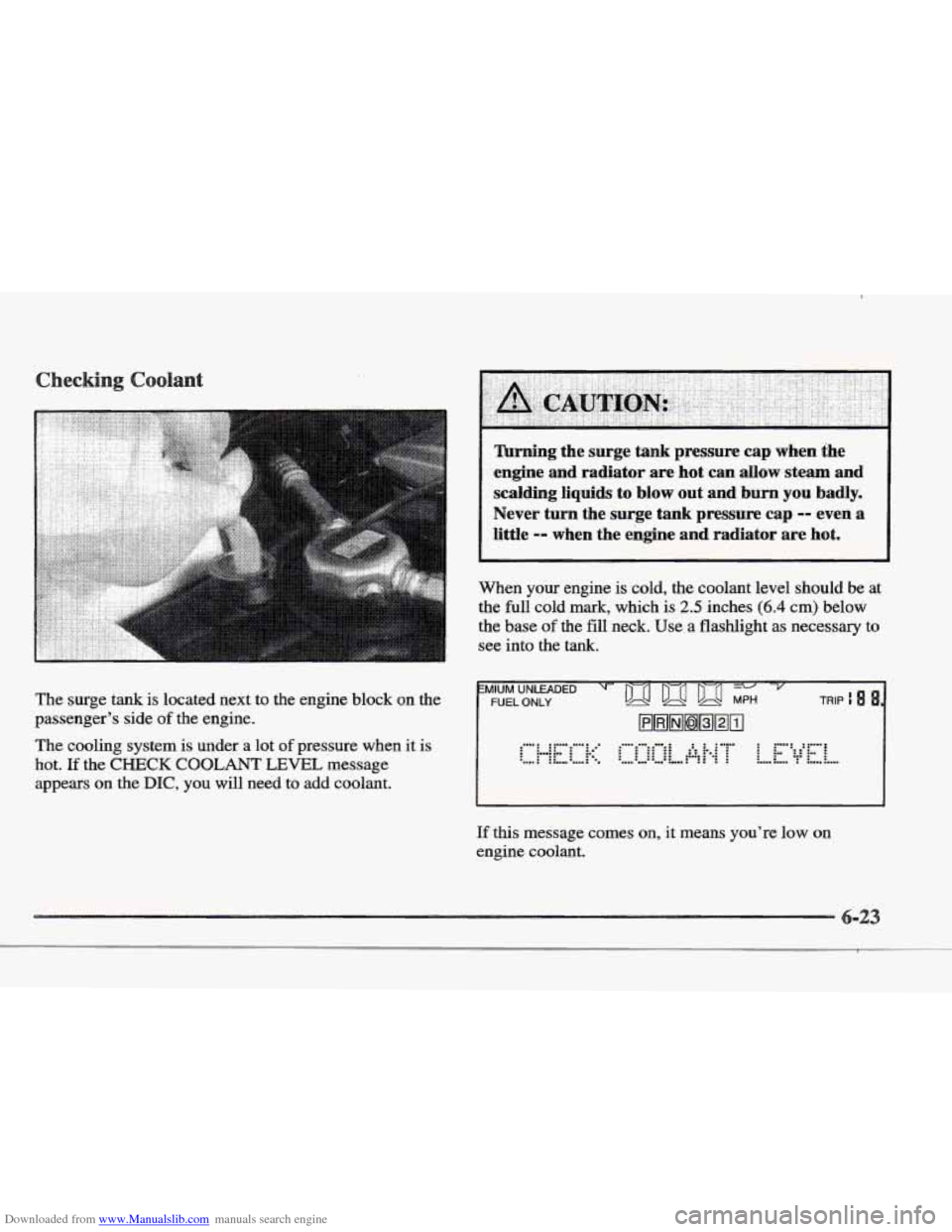
Downloaded from www.Manualslib.com manuals search engine The surge tank is located next to the engine block on the
passenger's side
of the engine.
The cooling system is under a lot
of pressure when it is
hot. If the CHECK COOLANT LEVEL message
appears on the
DIC, you will need to add coolant.
Turning the surge tank pressure cap when the
engine and radiator are hot can allow steam and
scalding liquids to blow out and burn you badly.
Never
turn the surge tank pressure cap =- even a
little -- when the engine and radiator are hot.
When your engine is cold, the coolant level should be at
the full cold mark,
which is 2.5 inches (6.4 cm) below
the base
of the fill neck. Use a flashlight as necessary to
see into the
tank.
MlUM UNLEADED - -
FUEL ONLY
DS Dg a ML
HHBHBBrn
........... ....... ." .......................... ...... ....... , : :: :: .-. :. : : ............. :.no. ... ..... : :L...-"..: ".L... ..... .............. .....
.... ...... ............ . .. . .I ......... .... . . -. . . .".. .".. .I.. ..". ." ...
If this message comes on, it means you're low on
engine
coolant.
Page 290 of 361

Downloaded from www.Manualslib.com manuals search engine Your brake master cylinder reservoir is here. It is filled
with
DOT-3 brake fluid.
There are only two reasons why the brake fluid level
in
the reservoir might go down. The first is that the brake
fluid goes down to an acceptable level during normal
brake lining wear. When new linings are put in, the fluid
level goes back up. The other reason
is that fluid is
leakng out of the brake system. If it is, you should have
your brake system fixed, since a leak means that sooner
or later your brakes won’t work well, 01- w~n’t work
at all.
so, it isn’t a good idea to “top off’ your brake fluid.
Adding brake fluid won’t correct a leak.
If you add fluid
when your linings are
worn, then you’ll have too much
fluid when you
get new brake linings. YOU should add
(or remove) brake fluid, as necessary, only when work is
done
on the brake hydraulic system.
When your brake fluid
falls to a low level, your brake
warning light will come on. See “Brake System Warning
Light” in the Index.
Page 292 of 361
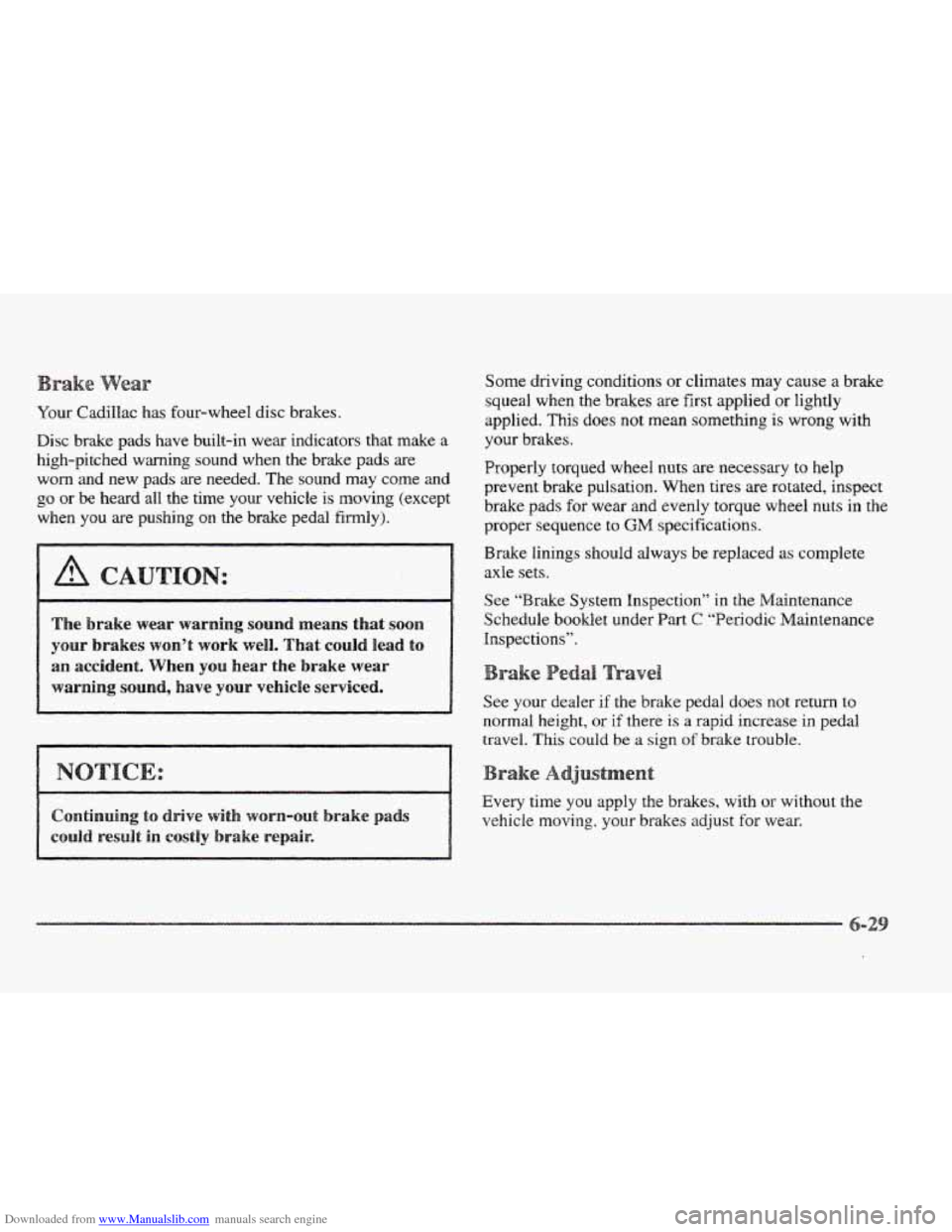
Downloaded from www.Manualslib.com manuals search engine Your Cadillac has four-wheel disc brakes.
Disc brake pads have built-in wear indicators that make a
high-pitched warning sound when the brake pads
are
worn and new pads are needed. The sound may come and
go or be heard all the time your vehicle is moving (except
when you are pushing on the brake pedal firmly).
The brake wear warning sound means that soon
your brakes won9$ work well. That could lead to
an accident. When you hear the brake wear
warning sound, have your vehicle serviced.
Some driving conditions or climates may cause a brake
squeal when the brakes are first applied or lightly
applied. This does
not mean something is wrong with
your brakes.
Properly torqued
wheel nuts are necessary to help
prevent brake pulsation. When tires are rotated, inspect
brake pads for wear and evenly torque wheel
nuts in the
proper sequence to GM specifications.
Brake linings should always be replaced
as complete
axle
sets.
See “Brake System Inspection” in the Maintenance
Schedule booklet under Part
C “Periodic Maintenance
Inspections”.
See your dealer
if the brake pedal does not return to
normal height, or if there is a rapid increase in pedal
travel. This could be a sign of brake trouble.
Every time you apply the brakes, with or without the
vehicle
moving, your brakes adjust for wear.
Page 306 of 361
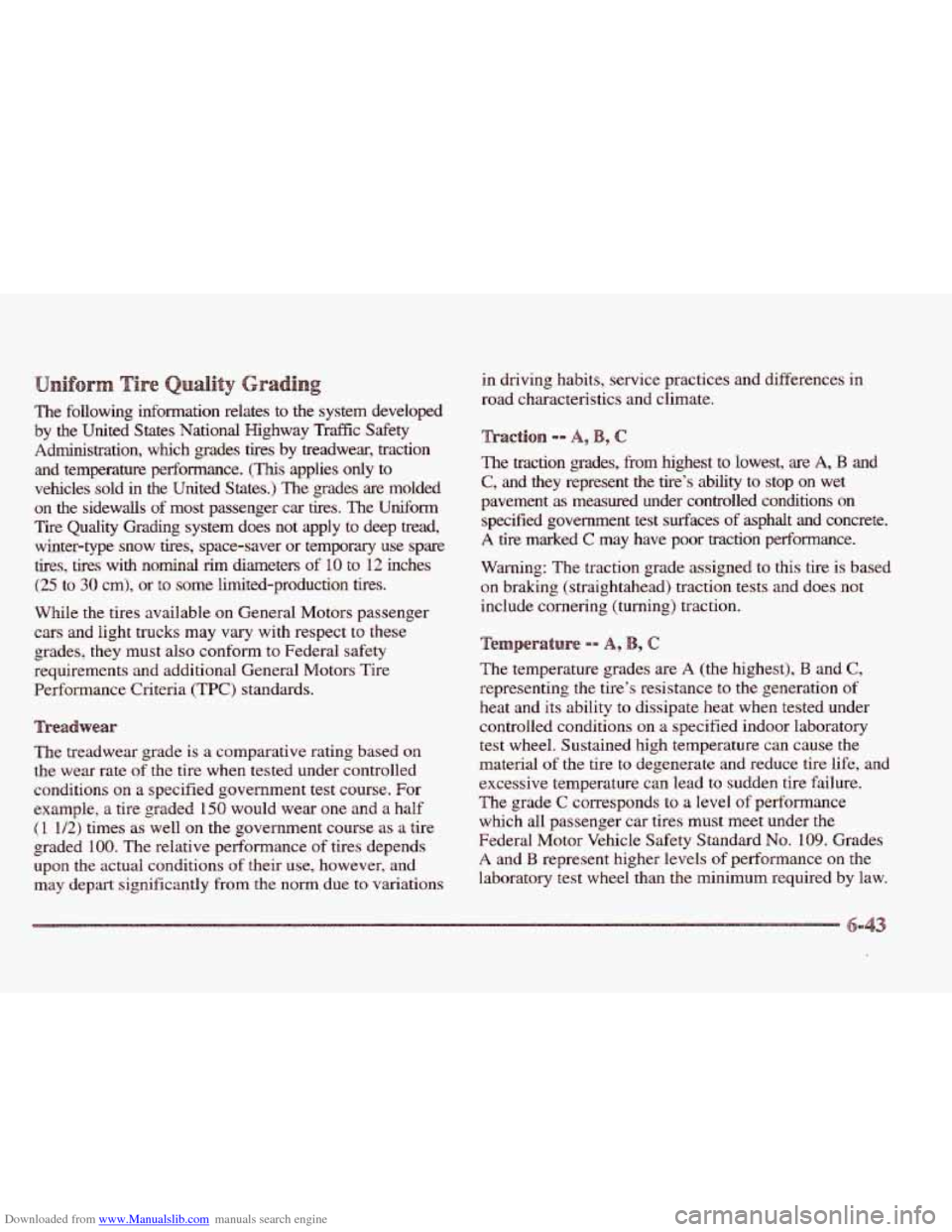
Downloaded from www.Manualslib.com manuals search engine The following information relates to the system developed
by the United States National Highway Traffic Safety
Administration, which grades tires by treadwear, traction
and temperature performance.
(This applies only to
vehicles sold in the United States.) The grades are molded
on
the sidewalls of most passenger car tires. The Uniform
Tire Quality Grading system does not apply to deep tread, winter-type snow tires, space-saver or temporary use spare
tires, tires with nominal rim diameters of 10 to 12 inches
(25 to 30 cm), or to some limited-production tires.
While the tires available on General Motors passenger
cars and
light trucks may vary with respect to these
grades, they must also conform
to Federal safety
requirements and additional General Motors Tire
Performance Criteria
(TPC) standards.
eadwear
The treadwear grade is a comparative rating based on
the wear rate of the tire when tested under controlled
conditions
on a specified government test course. For
example, a tire graded 150 would wear one and a haIf
( 1 1/2) times as well on the government course as a tire
upon the actual conditions of their use, however, and
may depart significantly from the norm due to variations
b Oraded 100. The relative performance of tires depends in
driving habits, service practices and differences in
road characteristics and climate.
action -- A9
The traction grades, from highest to lowest, are A, €3 and
C, and they represent the tire’s ability to stop on wet
pavement as measured under controlled conditions on
specified government test surfaces of asphalt and concrete.
A tire marked C may have poor traction performance.
Warning:
The traction grade assigned to this tire is based
on braking (straightahead) traction tests and does not
include cornering (turning) traction.
~~~~~~~~~~~ -ID A?
The temperature grades are A (the highest), B and C,
representing the tire’s resistance to the generation of
heat and its ability to dissipate heat when tested under
controlled conditions on a specified indoor laboratory
test wheel. Sustained high temperature can cause the
material
of the tire to degenerate and reduce tire life, and
excessive temperature can lead to sudden
tire failure.
The grade
C corresponds to a level of performance
which all passenger car tires must meet under the
Federal Motor Vehicle Safety Standard
No. 109. Grades
A and B represent higher levels of performance on the
laboratory test wheel than the minimum required by law.
Page 310 of 361
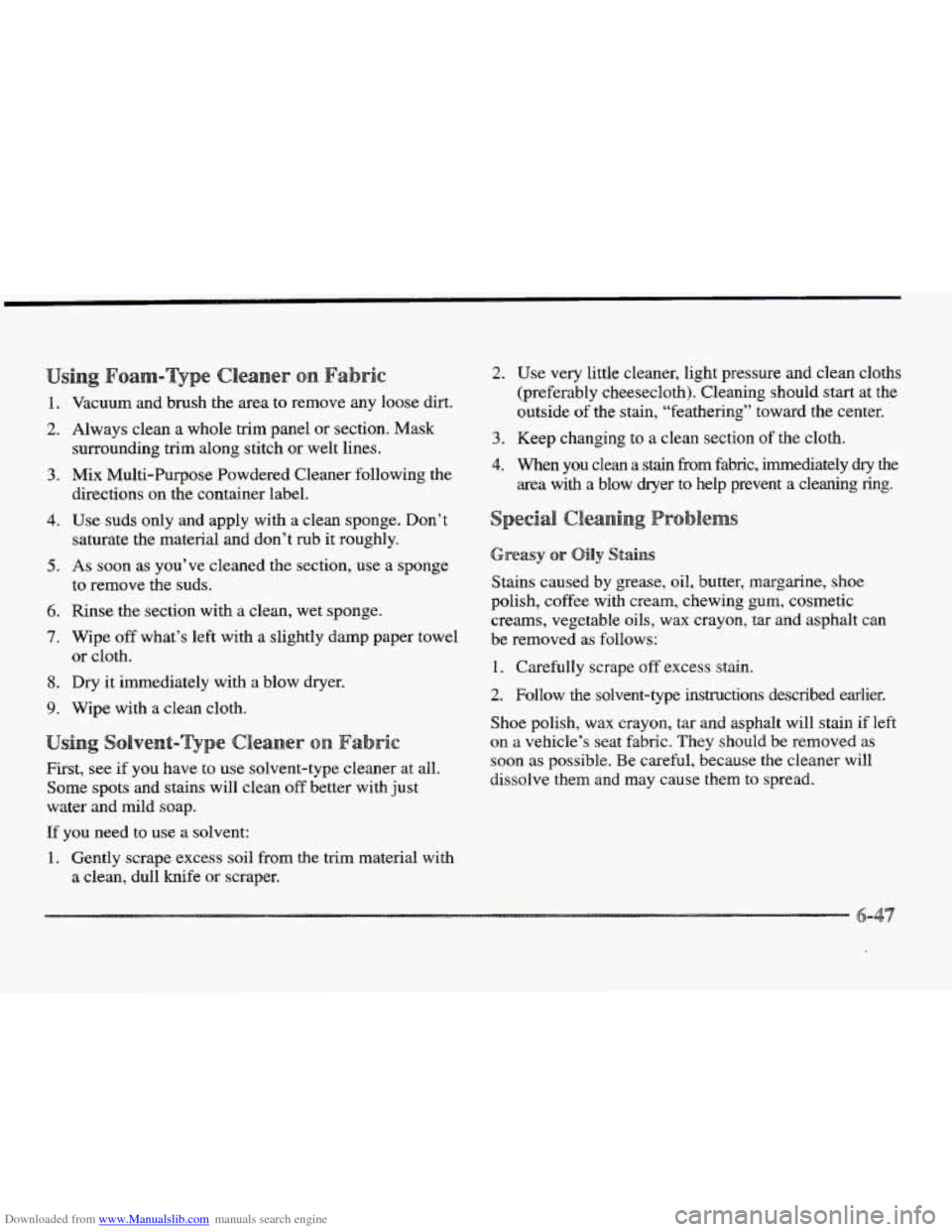
Downloaded from www.Manualslib.com manuals search engine si ric
1.
2.
3.
4.
5.
6.
7.
8.
9.
Vacuum and brush the area to remove any loose dirt.
Always clean a whole trim panel or section. Mask surrounding trim along stitch or welt lines.
Mix Multi-Purpose Powdered Cleaner following the directions on the container label.
Use suds only and apply with a clean sponge. Don’t
saturate the material and don’t rub
it roughly.
As soon as you’ve cleaned the section, use a sponge
to remove the suds.
Rinse the section with
a clean, wet sponge.
Wipe
off what’s left with a slightly damp paper towel
or cloth.
Dry it immediately with a blow dryer.
Wipe with a clean cloth.
si vent-
First, see if you have to use solvent-type cleaner at all.
Some spots and stains will clean
off better with just
water and mild soap.
If you need to use a solvent:
1. Gently scrape excess soil from the trim material with
a clean, dull knife
or scraper.
2. Use very little cleaner, light pressure and clean cloths
(preferably cheesecloth). Cleaning should start at the
outside of the stain, “feathering” toward the center.
3. Keep changing to a clean section of the cloth.
4. When you clean a stain from fabric, immediately dry the
area with a blow dryer to help prevent a cleaning ring.
Stains caused by grease, oil, butter, margarine, shoe
polish, coffee with cream, chewing gum, cosmetic
creams, vegetable oils, wax crayon, tar and asphalt can
be removed
as follows:
1. Carefully scrape off excess stain.
2. Follow the solvent-type instructions described earlier.
Shoe polish, wax crayon, tar and asphalt will stain if left
on a vehicle’s seat fabric. They should
be removed as
soon as possible. Be careful, because the cleaner will
dissolve them and may cause
them to spread.
Page 311 of 361
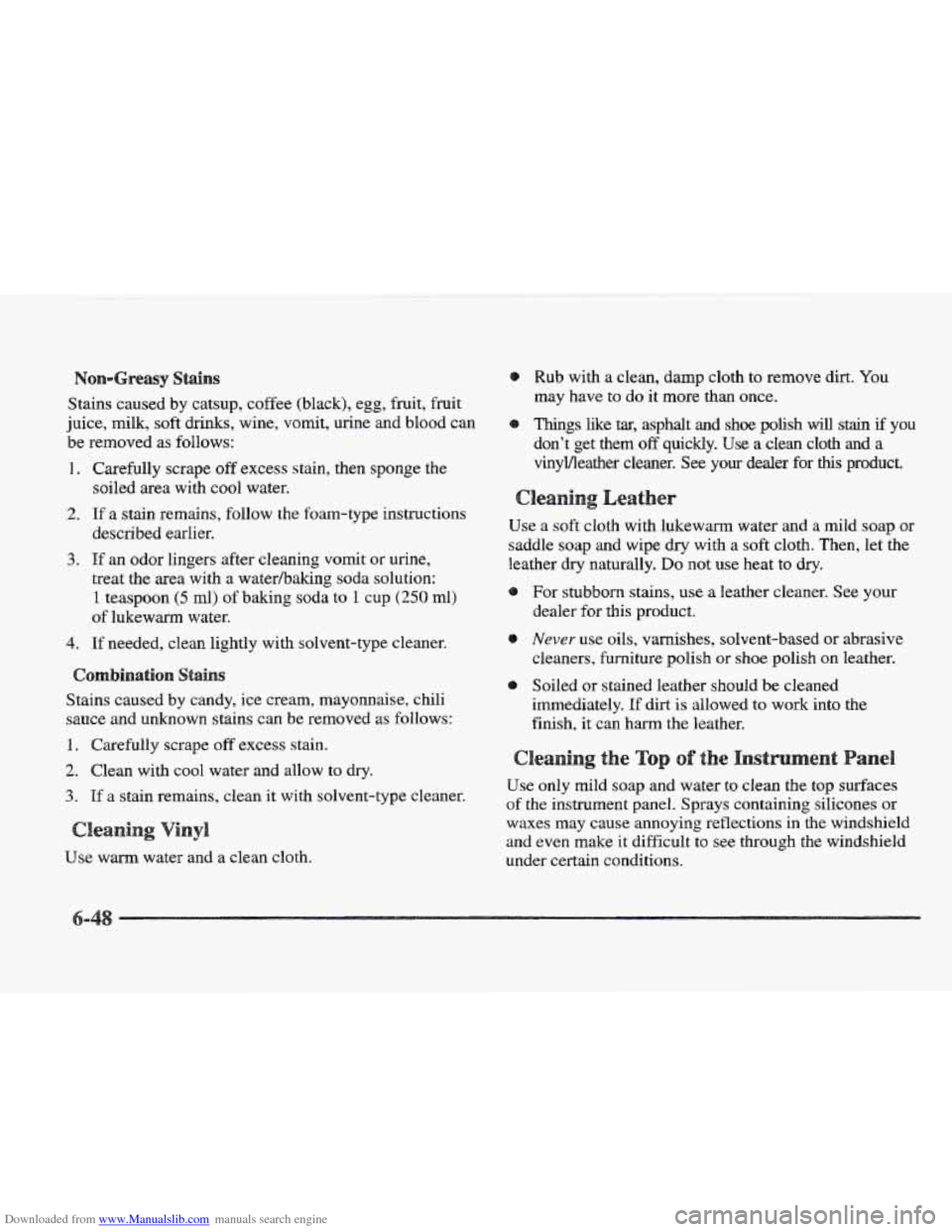
Downloaded from www.Manualslib.com manuals search engine Nan-Greasy stains
Stains caused by catsup, coffee (black), egg, fruit, fruit
juice, milk, soft drinks, wine, vomit,
urine and blood can
be removed
as follows:
1. Carefully scrape off excess stain, then sponge the
soiled area with
COO^ water.
2. If a stain remains, follow the foam-type instructions
3. If an odor lingers after cleaning vomit or urine,
treat the
area with a waterhaking soda solution:
1 teaspoon (5 ml) of baking soda to 1 cup (258 ml)
of lukewarm water.
described
earlier.
4. If needed, clean lightly with solvent-type cleaner.
Coanalbimatisn Stains
Stains caused by candy, ice cream, mayonnaise, chili
sauce and unknown stains
can be removed as follows:
1. Carefully scrape off excess stain.
2. Clean with cool water and allow to dry.
3. If a stain remains, clean it with solvent-type cleaner.
Use warm water and a clean cloth.
@ Rub with a clean, damp cloth to remove dirt. You
may have to
do it more than once.
Things like tar, asphalt and shoe polish will stain if you
don’t get them
off quickly. Use a clean cloth and a
vinyVleather cleaner. See
your dealer for this product.
Use a soft cloth with lukewarm water and a mild soap or
saddle soap and wipe dry
with a soft cloth. Then, let the
leather
dry naturally. Do not use heat to dry.
For stubborn stains, use a leather cleaner. See your
dealer for this product.
8 Never use oils, varnishes, solvent-based or abrasive
cleaners, furniture polish
or shoe polish on leather.
ta Soiled or stained leather should be cleaned
immediately. If dirt is allowed to work into the
finish, it can harm the leather.
Use
only mild soap and water to clean the top surfaces
of the instrument panel. Sprays containing silicones or
waxes may cause annoying reflections in the windshield
and even make it difficult to see through the windshield
under certain conditions.
Page 312 of 361
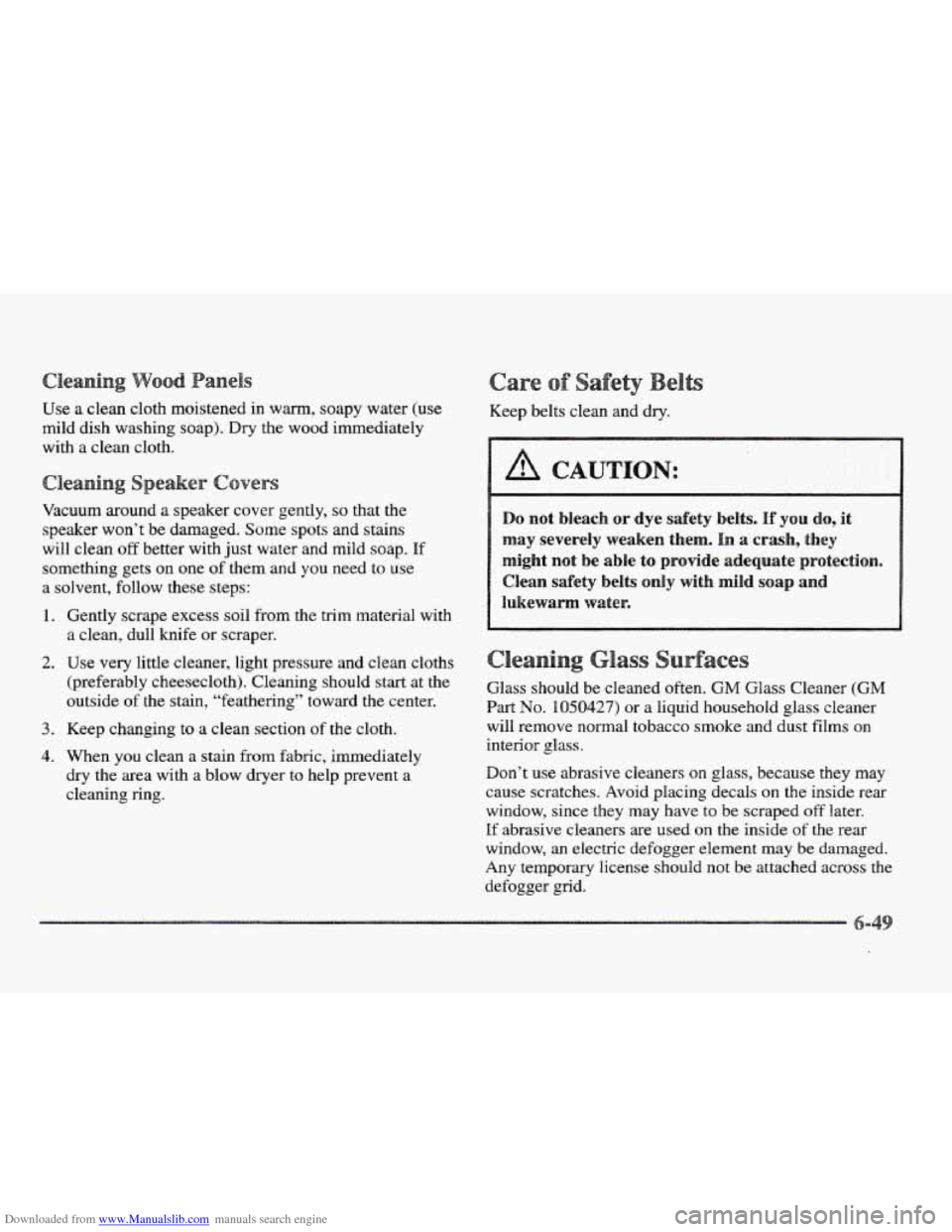
Downloaded from www.Manualslib.com manuals search engine Use a clean cloth moistened in warm, soapy water (use
mild dish washing soap). Dry the wood immediately
with a clean cloth.
Vacuum around
a speaker cover gently, so that the
speaker won’t be damaged. Some spots and stains
will clean
off better with just water and mild soap. If
something gets on one of them and you need to use
a solvent, follow these steps:
I. Gently scrape excess soil from the trim material with
2. Use very little cleaner, light pressure and clean cloths
(preferably cheesecloth). Cleaning should start at the
outside of the stain, “feathering” toward the center.
a
clean, dull knife or scraper.
3. Keep changing to a clean section of the cloth.
4. When you clean a stain from fabric, immediately
dry the area with a blow dryer
to help prevent a
cleaning ring.
a
Keep belts clean and dry.
U
CAUTION:
Do not bleach or dye safety belts. H you
may severely weaken them. In a crashg they
might not be able to provide adequate protection.
Clean safety belts only with mild soap and
lukewarm watere
ss
Glass should be cleaned often. GM Glass Cleaner (GM
Part No. 1050427) or a Liquid household glass cleaner
will remove normal tobacco smoke and dust films on
interior glass.
Don’t use abrasive cleaners
on glass, Decause they may
cause scratches. Avoid placing decals on the inside rear
window, since they
may have to be scraped off later.
If abrasive cleaners are used on the inside of the rear
window, an electric defogger element
may be damaged.
Any temporary license should not
be attached across the
defogger grid.
Page 320 of 361
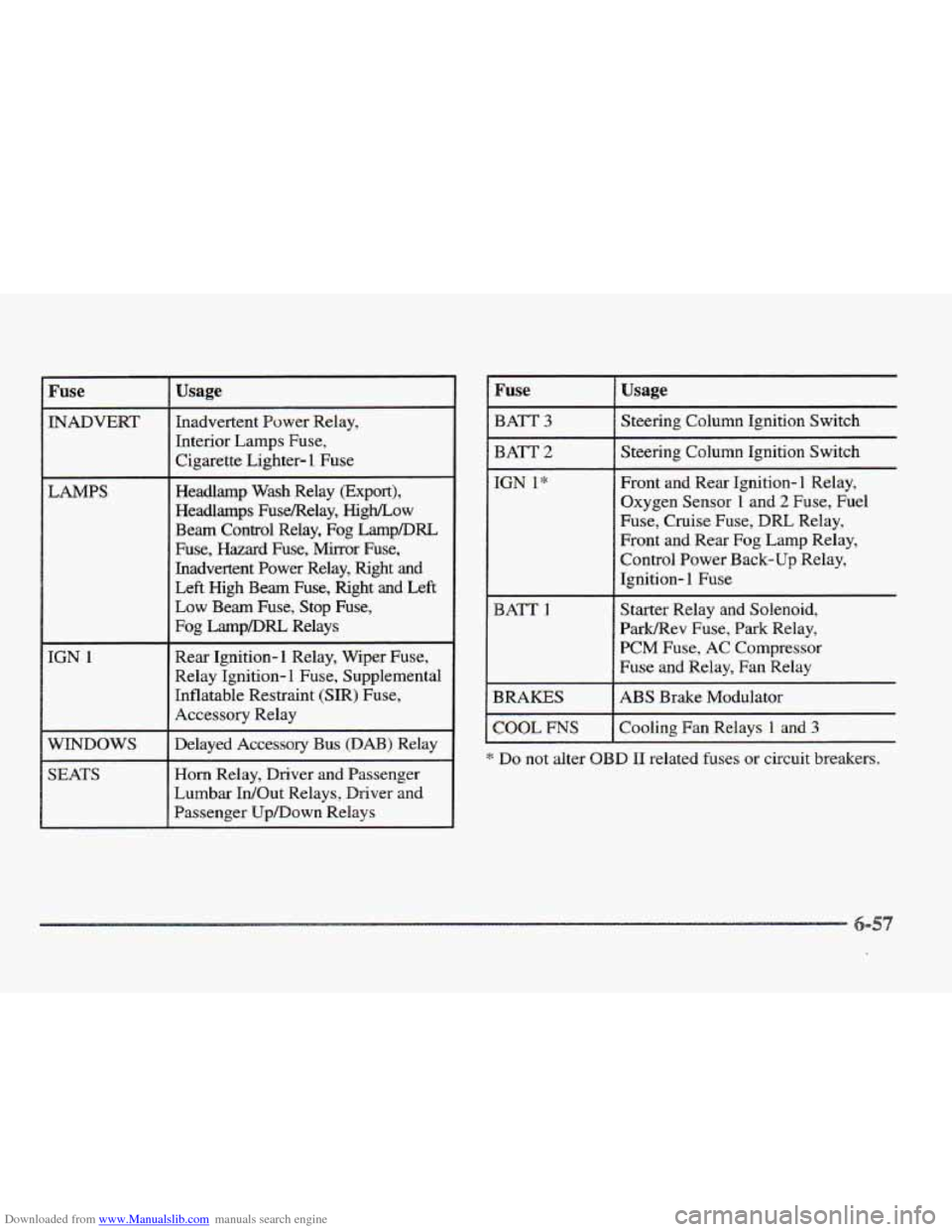
Downloaded from www.Manualslib.com manuals search engine Fuse
INADVERT
LAMPS
____~
IGN 1
WINDOWS
SEATS
Usage
Inadvertent Power Relay,
Interior Lamps
Fuse,
Cigarette Lighter- 1 Fuse
Headlamp Wash Relay (Export),
Headlamps FuseRelay,
High/Low
Beam Control Relay, Fog LampDRL
Fuse, Hazard Fuse, Mirror Fuse,
Inadvertent Power Relay, Right
and
Left High Beam Fuse, Right and Left
Low Beam Fuse, Stop Fuse,
Fog LampDRL Relays
Rear Ignition-1 Relay, Wiper Fuse,
Relay Ignition-
1 Fuse, Supplemental
Inflatable Restraint (SIR) Fuse,
Accessory Relay
Delayed Accessory Bus
(DAB) Relay
Horn Relay, Driver and Passenger
Lumbar IdOut Relays, Driver and
Passenger Up/Down Relays
I Fuse
I BATT 3
I BATT 2
I COOL ms
Usage
Steering Column Ignition Switch
Steering Column Ignition Switch
Front and Rear Ignition- 1 Relay,
Oxygen Sensor
1 and 2 Fuse, Fuel
Fuse, Cruise
Fuse, DRL Relay,
Front and
Rear Fog Lamp Relay,
Control Power Back-up Relay,
Ignition-
1 Fuse
Starter Relay and Solenoid,
Park/Rev Fuse,
Park Relay,
PCM Fuse,
AC Compressor
Fuse and Relay, Fan Relay
ABS Brake Modulator
Cooling Fan Relays
1 and 3
* Do not alter OBD I1 related fuses or circuit breakers.